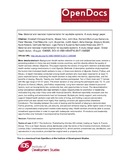| dc.contributor.author | Ekirapa-Kiracho, E. | |
| dc.contributor.author | Tetui, M. | |
| dc.contributor.author | Bua, J. | |
| dc.contributor.author | Kananura, R.M. | |
| dc.contributor.author | Waiswa, P. | |
| dc.contributor.author | Makumbi, F. | |
| dc.contributor.author | Atuyambe, L. | |
| dc.contributor.author | Ajeani, J. | |
| dc.contributor.author | George, A. | |
| dc.contributor.author | Mutebi, A. | |
| dc.contributor.author | Kakaire, A. | |
| dc.contributor.author | Namazzi, G. | |
| dc.contributor.author | Paina, L. | |
| dc.contributor.author | Kiwanuka, S.N. | |
| dc.coverage.spatial | Uganda | en |
| dc.date.accessioned | 2017-10-03T15:36:28Z | |
| dc.date.available | 2017-10-03T15:36:28Z | |
| dc.date.issued | 2017-09-06 | |
| dc.identifier.citation | Elizabeth Ekirapa-Kiracho, Moses Tetui, John Bua, Rornald Muhumuza Kananura, Peter Waiswa, Fred Makumbi, Lynn Atuyambe, Judith Ajeani, Asha George, Aloysuis Mutebi, Ayub Kakaire, Gertrude Namazzi, Ligia Paina & Suzanne Namusoke Kiwanuka (2017) Maternal and neonatal implementation for equitable systems. A study design paper, Global Health Action, 10:sup4, 1346925, DOI:10.1080/16549716 | en |
| dc.identifier.uri | https://opendocs.ids.ac.uk/opendocs/handle/20.500.12413/13255 | |
| dc.description.abstract | Background: Evidence on effective ways of improving maternal and neonatal health outcomes is widely available. The challenge that most low-income countries grapple with is implementation at scale and sustainability. Objectives: The study aimed at improving access to quality maternal and neonatal health services in a sustainable manner by using a participatory action research approach.
Methods: The study consisted of a quasi-experimental design, with a participatory action research approach to implementation in three rural districts (Pallisa, Kibuku and Kamuli) in Eastern Uganda. The intervention had two main components; namely, community empowerment for comprehensive birth preparedness, and health provider and management capacity-building. We collected data using both quantitative and qualitative methods using household and facility-level structured surveys, record reviews, key informant interviews and focus group discussions. We purposively selected the participants for the qualitative data collection, while for the surveys we interviewed all eligible participants in the sampled households and health facilities. Descriptive statistics were used to describe the data, while the difference in difference analysis was used to measure the effect of the intervention. Qualitative data were analysed using thematic analysis. Conclusions: This study was implemented to generate evidence on how to increase access to quality maternal and newborn health services in a sustainable manner using a multisectoral participatory approach. | en |
| dc.description.sponsorship | DFID | en |
| dc.language.iso | en | en |
| dc.publisher | Taylor & Francis Open | en |
| dc.relation.ispartofseries | Global Health Action;10:Supplement 4 | |
| dc.rights.uri | http://creativecommons.org/licenses/by/4.0/ | en |
| dc.subject | Health | en |
| dc.title | Maternal and Neonatal Implementation for Equitable Systems. A Study Design Paper | en |
| dc.type | Article | en |
| dc.rights.holder | Taylor & Francis Group | en |
| dc.identifier.externaluri | http://www.tandfonline.com/doi/full/10.1080/16549716.2017.1346925 | en |
| dc.identifier.team | Health and Nutrition | en |
| dc.identifier.doi | http://dx.doi.org/10.1080/16549716.2017.1346925 | |
| rioxxterms.funder | Default funder | en |
| rioxxterms.identifier.project | Future Health Systems | en |
| rioxxterms.version | NA | en |
| rioxxterms.versionofrecord | 10.1080/16549716.2017.1346925 | en |
| rioxxterms.funder.project | 50c0b576-b4b1-402e-a6cd-50d73c1d4430 | en |


